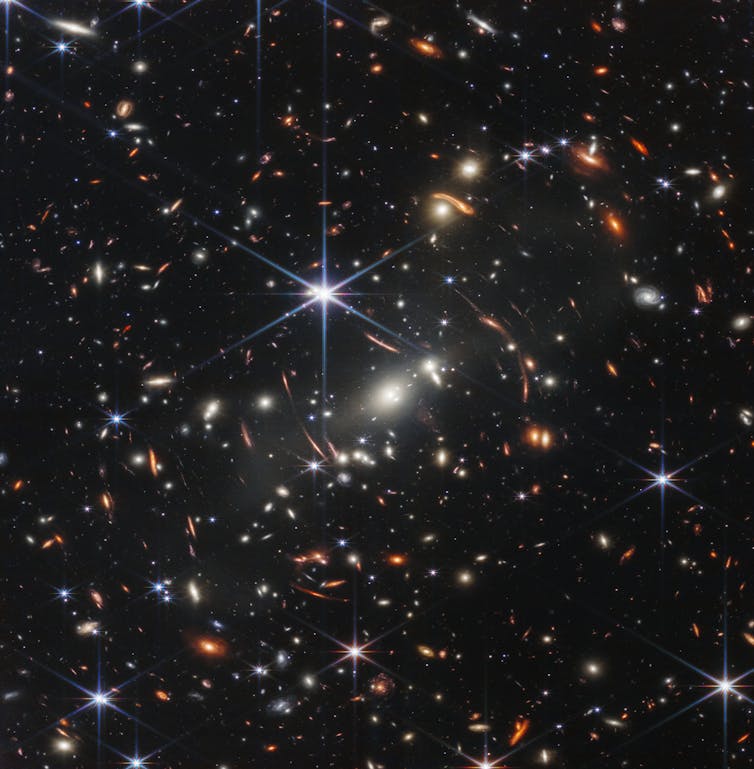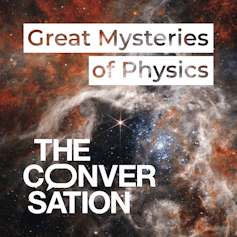The multiverse: our universe is suspiciously unlikely to exist – unless it is one of many
It’s easy to envisage other universes, governed by slightly different laws of physics, in which no intelligent life, nor indeed any kind of organised complex systems, could arise. Should we therefore be surprised that a universe exists in which we were able to emerge?

Estimated reading time: 13 minutes
Martin Rees, University of Cambridge
That’s a question physicists including me have tried to answer for decades. But it is proving difficult. Although we can confidently trace cosmic history back to one second after the Big Bang, what happened before is harder to gauge. Our accelerators simply can’t produce enough energy to replicate the extreme conditions that prevailed in the first nanosecond.
But we expect that it’s in that first tiny fraction of a second that the key features of our universe were imprinted.
The conditions of the universe can be described through its “fundamental constants” – fixed quantities in nature, such as the gravitational constant (called G) or the speed of light (called C). There are about 30 of these representing the sizes and strengths of parameters such as particle masses, forces or the universe’s expansion. But our theories don’t explain what values these constants should have. Instead, we have to measure them and plug their values into our equations to accurately describe nature.

This is article is accompanied by a podcast series called Great Mysteries of Physics which uncovers the greatest mysteries facing physicists today – and discusses the radical proposals for solving them.
The values of the constants are in the range that allows complex systems such as stars, planets, carbon and ultimately humans to evolve. Physicists have discovered that if we tweaked some of these parameters by just a few percent, it would render our universe lifeless. The fact that life exists therefore takes some explaining.
Some argue it is just a lucky coincidence. An alternative explanation, however, is that that we live in a multiverse, containing domains with different physical laws and values of fundamental constants. Most might be wholly unsuitable for life. But a few should, statistically speaking, be life-friendly.
Impending revolution?
What is the extent of physical reality? We’re confident that it’s more extensive than the domain that astronomers can ever observe, even in principle. That domain is definitely finite. That’s essentially because, like on the ocean, there’s a horizon that we can’t see beyond. And just as we don’t think the ocean stops just beyond our horizon, we expect galaxies beyond the limit of our observable universe. In our accelerating universe, our remote descendants will also never be able to observe them.
Most physicists would agree there are galaxies that we can’t ever see, and that these outnumber the ones we can observe. If they stretched far enough, then everything we could ever imagine happening may be repeated over and over. Far beyond the horizon, we could all have avatars.
This vast (and mainly unobservable) domain would be the aftermath of “our” Big Bang – and would probably be governed by the same physical laws that prevail in the parts of the universe we can observe. But was our Big Bang the only one?
The theory of inflation, which suggests that the early universe underwent a period when it doubled in size every trillionth of a trillionth of a trillionth of a second has genuine observational support. It accounts for why the universe is so large and smooth, except for fluctuations and ripples that are the “seeds” for galaxy formation.
But physicists including Andrei Linde have shown that, under some specific but plausible assumptions about the uncertain physics at this ancient era, there would be an “eternal” production of Big Bangs – each giving rise to a new universe.
String theory, which is an attempt to unify gravity with the laws of microphysics, conjectures everything in the universe is made up of tiny, vibrating strings. But it makes the assumption that there are more dimensions than the ones we experience. These extra dimensions, it suggests, are compacted so tightly together that we don’t notice them all. And each type of compactification could create a universe with different microphysics – so other Big Bangs, when they cool down, could be governed by different laws.
The “laws of nature” may therefore, in this still grander perspective, be local by-laws governing our own cosmic patch.
If physical reality is like this, then there’s a real motivation to explore “counterfactual” universes – places with different gravity, different physics and so forth – to explore what range or parameters would allow complexity to emerge, and which would lead to sterile or “stillborn” cosmos. Excitingly, this is ongoing, with recent reseach suggesting you could imagine universes that are even more friendly to life than our own. Most “tweakings” of the physical constants, however, would render a universe stillborn.
That said, some don’t like the concept of the multiverse. They worry it would render the hope for a fundamental theory to explain the constants as vain as Kepler’s numerological quest to relate planetary orbits to nested platonic solids.
But our preferences are irrelevant to the way physical reality actually is – so we should surely be open minded to the possibility of an imminent grand cosmological revolution. First we had the Copernican realisation that the Earth wasn’t the centre of the Solar System – it revolves around the Sun. Then we realised that there are zillions of planetary systems in our galaxy, and that there are zillions of galaxies in our observable universe.
So could it be that our observable domain – indeed our Big Bang – is a tiny part of a far larger and possibly diverse ensemble?
Physics or metaphysics?
How do we know just how atypical our universe is? To answer that we need to work out the probabilities of each combination of constants. And that’s a can of worms that we can’t yet open – it will have to await huge theoretical advances.
We don’t ultimately know if there are other Big Bangs. But they’re not just metaphysics. We might one day have reasons to believe that they exist.
Specifically, if we had a theory that described physics under the extreme conditions of the ultra-early Big Bang – and if that theory had been corroborated in other ways, for instance by deriving some unexplained parameters in the standard model of particle physics – then if it predicted multiple Big Bangs, we should take it seriously.
Critics sometimes argue that the multiverse is unscientific because we can’t ever observe other universes. But I disagree. We can’t observe the interior of black holes, but we believe what physicist Roger Penrose says about what happens there – his theory has gained credibility by agreeing with many things we can observe.
About 15 years ago, I was on a panel at Stanford where we were asked how seriously we took the multiverse concept – on the scale “would you bet your goldfish, your dog, or your life” on it. I said I was nearly at the dog level. Linde said he’d almost bet his life. Later, on being told this, physicist Steven Weinberg said he’d “happily bet Martin Rees’ dog and Andrei Linde’s life”.
Sadly, I suspect Linde, my dog and I will all be dead before we have an answer.
Indeed, we can’t even be sure we’d understand the answer – just as quantum theory is too difficult for monkeys. It’s conceivable that machine intelligence could explore the geometrical intricacies of some string theories and spew out, for instance, some generic features of the standard model. We’d then have confidence in the theory and take its other predictions seriously.
But we’d never have the “aha” insight moment that’s the greatest satisfaction for a theorist. Physical reality at its deepest level could be so profound that its elucidation would have to await posthuman species – depressing or exhilarating as that may be, according to taste. But it’s no reason to dismiss the multiverse as unscientific.![]()
Martin Rees, Emeritus Professor of Cosmology and Astrophysics, University of Cambridge
This article is republished from The Conversation under a Creative Commons license. Read the original article.
What's Your Reaction?
























